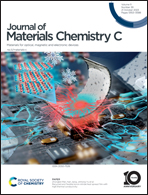Melamine foam-induced isotropic graphite foam for effective thermal management and electromagnetic interference shielding†
Abstract
In this work, a series of high-performance graphite foams (GFs) were synthesized using a melamine foam (MF) template-assisted strategy, which employed AR mesophase pitch (AR MP) as the carbon precursor and airflow was applied to achieve orientation and solidification in the MF network combined with carbonization and graphitization. The results show that the thermal conductivity, compressive strength, and graphitization degree of GFs increase with an increase in AR MP slurry concentration. In contrast, the electromagnetic interference shielding effectiveness (EMI SE) and porosity exhibit an opposite trend. When the concentration was 70 wt%, GF-70 displays isotropic thermal conductivity reaching up to 74.29 W m−1 K−1 in-plane and 76.27 W m−1 K−1 through-plane. Meanwhile, it also shows an EMI SE of 35 dB in the X-band. However, when the concentration drops to 40 wt%, the EMI SE of GF-40 reaches 71 dB, and thermal conductivities of 32.13 W m−1 K−1 and 31.46 W m−1 K−1 in two planes have been achieved in GF-40. The isotropic performance of GFs is related to the structure of the template. At the same time, the superior thermal conductivity of GFs is attributed to the ligaments of a parallel arrangement. The outstanding electromagnetic shielding effectiveness (EMI SE) is ascribed to the porous structure's multiple reflections and repeated scattering. This strategy of the adjustable combination of thermal conductivity and EMI SE paves the way for dual-function thermal management materials.



 Please wait while we load your content...
Please wait while we load your content...